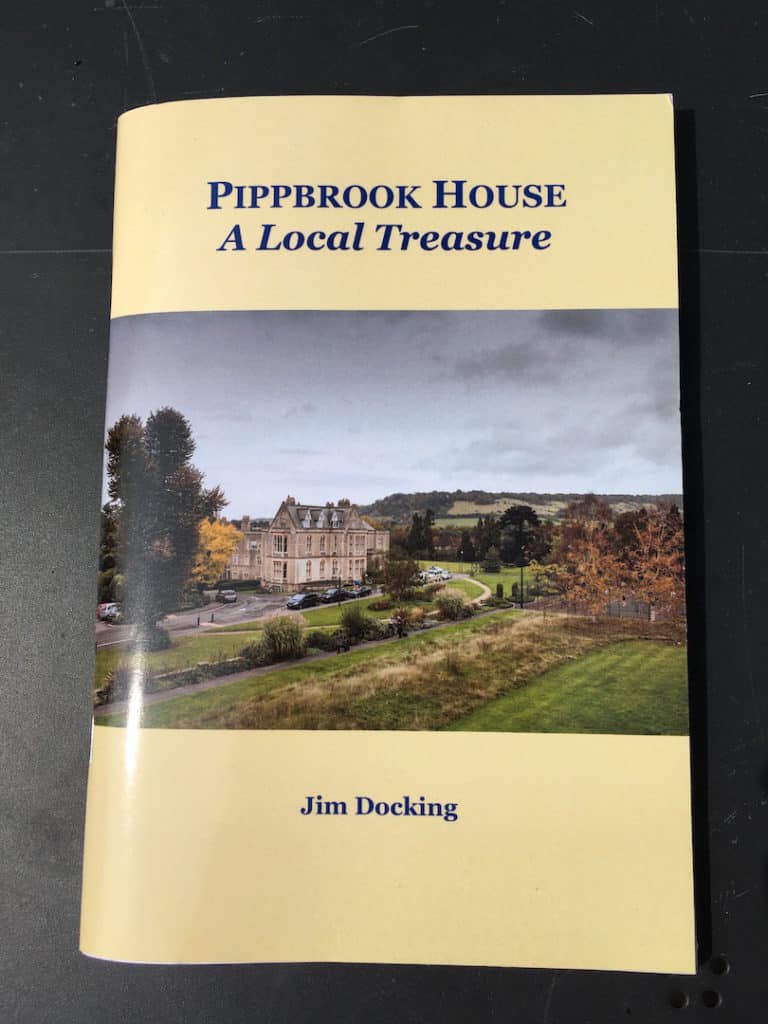Prepared by Dorking and District U3A for Transition Dorking.
Thank you to Jacqui Hamlin for letting us publish this transcript.

Built between 1856 and 1858, the present Pippbrook House in Dorking was designed by the distinguished architect George Gilbert Scott. Although a number of great houses can be found within the Mole Valley area, Pippbrook is the only old country mansion in the town of Dorking that has survived reasonably intact. Moreover, with its richly decorated interior and painted ceilings, Pippbrook House is now a Grade II* listed building, a distinction that English Heritage bestows on only a very small proportion of listed properties.
Compiling this short history of Pippbrook House, previously just called Pippbrook, has revealed three main periods for attention. First, there is the early period, including the history of previous houses on this site and that of the existing house, with a focus on its architectural and cultural importance. Then there is the period covered by its municipal ownership, with its civil implications and personal and emotional ties, particularly during the years just before and during the Second World War. Investigation of this period has revealed many significant decisions and activities taking place within the walls of Pippbrook. And, finally, there is the very important current period during which its history is still being created.
EARLY PERIOD
Pippbrook estate has a long history, stretching back to the Middle Ages. Its name derives from its earliest known owners, Walter atte Pyppe and his wife Alicia, who bought the land in 1378 – although it was not until around 1750 that the name Pippbrook was applied. The owner of the earliest known house on the estate, built probably in the late 14th century, was Ayre Brocke before it was bought in 1546 by William Burt. At his death no heir could be found, so the Manorial Courts passed the house to Burt’s cousin, Elizabeth, whose husband was called William.
No evidence has been found about later developments until 1758, when the owner, William Page, pulled down the house and replaced it with a new one. He resided there until 1764, when Mark Baskett became the owner for the next six years. From 1770, there were a further nine owners, whose names are not currently known.
From 1849 until 1889, the house was owned by the Forman family, who amassed a fortune as proprietors of ironworks in South Wales, and used their wealth to contribute much to the life of Dorking and enrich its amenities. Thomas Seaton (b. 1791), who had previously lived in London and Glamorganshire, was the first Foreman to own the house, which he bought in 1849. In her book about the history of St Martin’s Church and parish, Alexandra Wedgwood notes that purchasing property in the leafy home counties was fashionable among wealthy men at the time because the new railways had made access to these parts so much easier. Like the future Formans, Thomas was community-minded, becoming Chairman of the Dorking Bench of Magistrates and High Sheriff of Surrey. A painting titled ‘Cricket Match at Cotmandene, Dorking’, dated about 1770, which hangs in the Writing Room of Lord’s Cricket Ground, shows a large three-storey house in the bottom left corner. Archives of the Marylebone Cricket Club reveal that this is the Pippbrook House that Thomas bought.
PRESENT HOUSE
Barely a year after Thomas bought the house, he died. Because he had no children, he left Pippbrook to his brother, the millionaire William Henry Forman (b.1794), owner of the prosperous Penydarren ironworks at Merthyr Tydfil until 1859. William decided to use some of his wealth, estimated then to be up to £5 million, to re-build and also extend Pippbrook House to designs by the prolific architect, George Gilbert Scott, a Victorian Gothic revivalist knighted in 1872. The owner’s interest in the iron industry is reflected by the ironwork in the new house. However, Thomas Foreman’s widow Elizabeth continued to live in Pippbrook and was later joined by her younger sister, Hannah. In local directories of the time, it is Elizabeth Forman rather than William who is listed as the resident, and the census returns of 1851 and 1861 both describe her as ‘Head of House’, while William is described simply as ‘Visitor’ (as well as ‘Unmarried’ and ‘Proprietor of Iron Mines’). This is probably because William owned other houses in Doncaster and Tunbridge Wells, using his Dorking residence only from time to time.
When Elizabeth died on 5 July 1889, followed by her husband just a few months later, ownership of Pippbrook House was beset by a family dispute. The matter was referred to the Court of Chancery, which ordered that the 26-acre estate be sold by auction in four lots, of which the house was one. On 18 July 1890, the auctioneers Norton Trist and Gilbert advertised the house as a ‘commodious well arranged family mansion […] with a suite of well proportioned reception rooms’, surrounded by ‘delightful and charming scenery, including the far-famed Box Hill, in delightful pleasure grounds and gardens tastefully laid out’. The sale also included an entrance lodge, stabling, rooms for the coachman, cottages for the cowman and gardener, outbuildings and farm, conservatory, plus two small detached cottages known as Devonshire and Branscombe, seven other cottages, smithy, orchard, paddocks and meadow land.
The house was not sold immediately, but Thomas Aggs bought it for £12,000 in February 1891. Nothing seems known about him, except that he came from Clapham and was a banker. He and his heirs lived in the house for 37 years. When he died on 17 November 1897, the property was passed on to his widow, Anna Christy Aggs, and when she died her son, Henry Gurney Aggs (also a banker) inherited Pippbrook and lived there for 15 years. Unfortunately, Henry allowed the building to fall into a dilapidated state, and in that condition it was sold to John Alexander Lloyd in 1928 who wanted to demolish the house, presumably to build others on the site.
However, Pippbrook was saved when the then Dorking Urban District Council bought it in December 1930 for its offices, which opened there a year later. By a covenant in the Land Registry entries, the vendor and the council promised to ‘preserve the amenities of the whole estate in its future development’. From that time, for a period of more than 80 years, the house enjoyed public access since it was used first as the Council offices and for many community-related endeavours, and later as the town’s library.
MUNICIPAL OWNERSHIP (from 1930)
The Archives of Dorking Museum include very detailed records from the Dorking and Leatherhead Advertiser reporting the deliberations and decisions of Dorking Urban District Council, all taking place in the Council Offices in Pippbrook. In particular, because the house was purchased at the beginning of the troubled period leading to the Second World War, they record the precautions and preparations that were entrusted to the Council.
The Archives include touching records of the work of the Women’s Voluntary Services during that period. For example, the WVS sent a letter on 24 April, 1939, to notify all ‘Branches of Women’s Work locally in National Defence’ that there was a Centre in Pippbrook for Women’s Voluntary Services for Civil Defence to co-ordinate Air Raid Precautions, Hospital and Nursing Services, an Evacuation Scheme and Transport and ‘all other Defence jobs which women can undertake’. The WVS then worked from Pippbrook throughout the war and until transferring an office above Windibanks after about forty years. There are records of their invaluable work with refugees from areas subjected to bombing, and of programmes to distribute food and clothes as well as the ration books required by all members of the community.
It would have been from the WVS that one of our members recalls ‘being pushed in my pram [to Pippbrook] to collect the bottles of orange juice’ issued to children. The same member recounts that her father was an Air Raid Warden who patrolled the Pippbrook area. Pippbrook housed the Air Raid Protection post manned by the Civil Defence, and there was an air raid siren mounted on the roof of the building. On June 16, 1945, there was a ‘Farewell to ARP Social’ at Pippbrook, although the Civil Defence continued to exist into the Cold War in the 1950’s.
It was to Pippbrook that all men who were not exempt were summoned to register for Civil Defence duties on September 14, 20 and 21, 1941, according to their age groups.
Pippbrook, with a history stretching from the late fourteenth century, and transformed in the nineteenth century with the building of the existing house with its elegant, decorative interiors, thus began its period of highly significant and memorable service to the surrounding community. The nature of this service was changed yet again when the Council Offices were transferred to the new Pippbrook, and the existing house became Pippbrook House.
The most recent service to the community began with the leasing of Pippbrook House to Surrey County Council. Any newcomer to Dorking in those years would have been encouraged to come to ‘our beautiful Public Library’. Indeed, few Public Libraries would have been placed in such surroundings, or have been viewed with such great affection. Many members of the public enjoyed Heritage weekends in September when they had the opportunity to visit the rooms with their painted ceilings and intricately painted doors. One Library Assistant recounts that at Christmas time they hung a pair of red trousers stuffed into wellington boots ‘disappearing’ up the chimney in a beautiful Adams fireplace, to the fascination and delight of visiting children.
On 11 June 1973 English Heritage recognised the house as being of special architectural merit and historic interest by designating it a Grade II listed building. The house was upgraded to Grade II* in 2012. The Surrey Mirror described the house in October 2010 as ‘an architectural gem’, while June Spong in Dorking, Town Cities and Memories, published in 2010, described the doors as ornately carved with leaves and trees of England, the ceiling beautifully decorated in blues, reds, greens and yellows.
The Library has now moved to other premises, the building is not currently used by the community, and thus Pippbrook (House) is in a period of transition. The events of recent years will be included in the full version of the history of Pippbrook. The history of this house is closely tied to strong feelings in the Dorking community that this building, that is of high architectural interest and that has been of such significance in their lives for eighty years, should still serve them and belong to them.
Doreen Raine, Jim Docking
16 February, 2015.
Watch Mole Valley’s video of Pippbrook House filmed for 2020’s Heritage Open Days.

This is the story of Pippbrook Estate and House in Dorking, from the 14th century to the end of 2015.
It is a tale of wealthy owners who benefitted the local and national communities in various ways and of the uses to which the house was put during the period of municipal ownership from 1930.
The author was able to draw upon a wide range of both primary and secondary sources and to introduce much material that hasn’t been included in any previous publication.
The book is priced at £5.00. Buy it online here.
Last : Denbies


